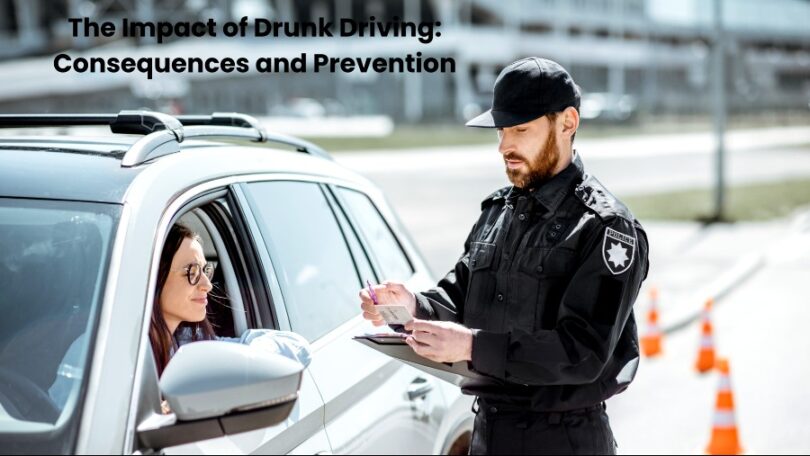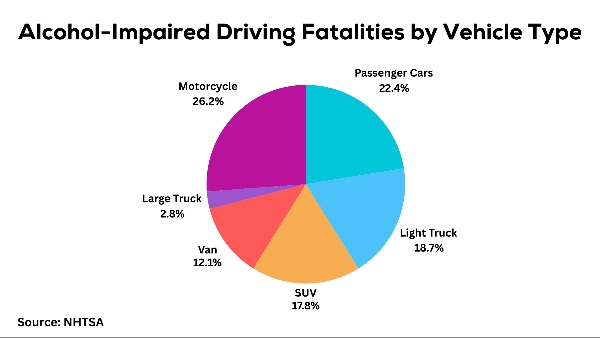Drunk driving is one of those completely preventable tragedies that continue to devastate communities across America year after year. Despite decades of public awareness campaigns and the enactment of tougher laws, the statistics surrounding alcohol-impaired driving remain staggering and heartbreaking. Even with all the efforts to curb this behavior, drunk driving continues to pose a significant problem on our roads.
The numbers speak volumes about the prevalence and dangers of driving under the influence. According to the National Highway Traffic Safety Administration, drunk driving kills more than 11,000 people each year in the U.S. between 2013-2022. Alcohol-related traffic fatalities make up nearly 32% of all traffic fatalities each year.
This guide will examine the devastating consequences of driving under the influence. With a combination of greater awareness, personal responsibility, and meaningful action, we have the power to tackle this epidemic head-on. Understanding the devastating effects of drinking and driving, and focusing on proven prevention methods, can save lives.
Consequences of Drunk Driving
The impact of drunk driving reverberates through communities, leaving a trail of devastation in its wake. In the aftermath of a car accident caused by impaired driving, victims often turn to Personal Injury Attorneys for guidance and support. These dedicated professionals specialize in representing individuals affected by such incidents, providing legal assistance and advocacy to pursue compensation for their injuries and losses.
Legal Repercussions
Driving under the influence carries severe legal consequences. Penalties for DUI convictions vary by state but typically include fines, license suspension, and possible jail time. In some cases, individuals may face felony charges, especially if the incident resulted in injury or death.
The impact of drunk driving extends far beyond the immediate incident, often resulting in devastating consequences for victims and their families. In Greenville, NC, where road safety is paramount, the need for awareness and prevention measures is crucial.
By raising awareness about the dangers of impaired driving and supporting preventive initiatives such as public education campaigns, stricter enforcement of DUI laws, and promoting alternative transportation options, communities can work together. They aim to reduce the incidence of drunk driving and its associated consequences. If you or a loved one has been involved in a drunk driving accident, it’s advisable to consult with a personal injury lawyer greenville nc to understand your legal options and rights.
The legal battles and financial burdens associated with a DUI conviction can be life-altering. It’s not just about the immediate penalties, a DUI conviction can impact future employment opportunities and even child custody arrangements.
According to the Federal Bureau of Investigation’s Uniform Crime Report, there were 215,789 arrests for driving under the influence in the United States. This figure highlights the prevalence of drunk driving incidents and the immense strain it puts on the legal system.
Physical and Health Consequences
The physical and health consequences of drunk driving cannot be overstated. Alcohol severely impairs a driver’s ability to operate a motor vehicle, increasing the risk of fatal accidents. Even small amounts of alcohol can significantly impair judgment, reaction time, and critical skills required for safe driving.
Injuries sustained in drunk driving accidents can range from minor cuts and bruises to severe traumatic brain injuries, paralysis, and even death. The long-term effects of these injuries can be devastating, impacting the quality of life for survivors and their families. According to the CDC, 1.8 million drivers were treated in emergency departments for non-fatal crash injuries in 2021.
Moreover, alcohol-impaired driving can have lasting psychological impacts, such as post-traumatic stress disorder (PTSD), anxiety, and depression, affecting both victims and perpetrators. For those seeking legal assistance, finding reputable personal injury lawyers near me is essential for accessing the support needed to navigate the aftermath of a drunk driving accident.
Social and Economic Impact
Beyond the personal toll, drunk driving has far-reaching social and economic consequences. Drunk driving claims 37 lives every day in the U.S., resulting in a death every 39 minutes. These tragic losses not only shatter families but also impact communities and local economies.
The economic burden of drunk driving is staggering.
The consequences of drunk driving are not limited to a specific type of vehicle. However, some vehicles are more susceptible to fatal accidents when operated under the influence. According to the National Highway Traffic Safety Administration (NHTSA), the distribution of alcohol-impaired driving fatalities by vehicle type in 2020 was as follows:
This pie chart highlights the disproportionate impact of drunk driving on light trucks and passenger cars, which accounted for the majority of alcohol-related fatalities. By understanding the distribution of alcohol-impaired driving fatalities by vehicle type, policymakers, and safety advocates can develop more effective strategies tailored to the specific risks and challenges associated with each category.
Preventive Measures and Effective Interventions
While the consequences of drunk driving are severe, various preventive measures and interventions can help mitigate the risks.
1. Public Awareness Campaigns
Public awareness campaigns have played a crucial role in changing attitudes and behaviors regarding drunk driving. Successful campaigns, such as Friends Don’t Let Friends Drive Drunk and Buzzed Driving Is Drunk Driving, have resonated with the public and contributed to a decline in alcohol-related fatalities.
2. Technological Innovations
Technological innovations have also proven effective in preventing drunk driving. Ignition interlock devices, which require drivers to breathe into a breathalyzer before starting their vehicles, have been mandated for certain DUI offenders in many states. These devices have shown promise, with drivers over 0.10 BAC being 7 times more likely to be involved in a fatal accident than sober drivers.
Additionally, automakers are exploring advanced alcohol detection systems that could automatically prevent a vehicle from starting if the driver is impaired.
3. Policy and Enforcement
Strict enforcement of DUI laws and lower blood alcohol concentration limits have contributed to the decrease in drunk driving fatalities. Many states have implemented zero-tolerance laws for underage drinking and driving, as well as increased penalties for repeat offenders and those with high BAC levels.
Effective policy and enforcement strategies, such as sobriety checkpoints and targeted enforcement during high-risk times (e.g., holidays and weekends) have proven successful in deterring drunk driving and raising awareness about the consequences.
Role of Education in Combating Drunk Driving
Education is a critical component in the fight against drunk driving. Comprehensive educational programs in schools and communities can equip individuals with the knowledge and skills necessary to make informed decisions and avoid getting behind the wheel while impaired. Successful educational initiatives often involve:
- Teaching the dangers of drunk driving and promoting responsible decision-making from an early age.
- Engaging youth in peer-led discussions and activities that foster positive peer influence.
- Partnering with local organizations, law enforcement, and health professionals to deliver consistent messaging and resources.
By fostering a culture of responsibility and accountability, educational programs can empower individuals to be advocates for safe driving practices.
Towards Safer Roads
From sobering statistics to heart-wrenching personal accounts, the multi-faceted approach to preventing drunk driving underscores the necessity for collective action. By embracing education, technology, and community involvement, we can drive down these numbers and save lives. Let us commit to making informed decisions and advocating for stricter measures against drunk driving.
Remember, the consequences of drunk driving extend far beyond the individual, they impact families, communities, and society as a whole. Together, we can create a culture of responsibility and ensure that no more lives are lost to this preventable tragedy.
Join the movement against drunk driving by supporting organizations that promote awareness and education. Pledge to be a responsible driver, and encourage your loved ones to do the same. Together, we can make a difference and create safer roads for everyone.
FAQs
1. What legal consequences do I face if caught driving under the influence?
Penalties for DUI convictions vary by state but typically include fines, license suspension, and possible jail time. Repeat offenders or those with aggravating factors (such as high BAC levels or causing injury/death) may face harsher penalties including felony charges and longer prison sentences.
2. How effective are ignition interlock devices in preventing drunk driving?
Ignition interlock devices have proven to be an effective deterrent for drunk driving. According to the CDC, these devices reduce repeat offenses by 67% while installed. Additionally, studies have shown that ignition interlocks can prevent 1.77 million potential drunk driving incidents annually.
3. Can education and awareness significantly reduce drunk driving incidents?
Yes, education and awareness play a crucial role in reducing drunk driving incidents. Comprehensive educational programs that target different age groups and demographics have been shown to have a positive impact on changing attitudes and behaviors related to drunk driving.









